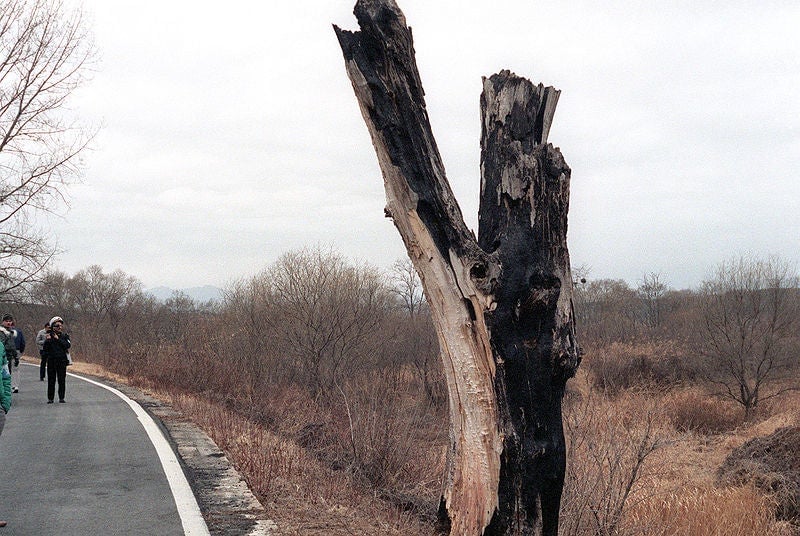The last symbolic tree in the DMZ nearly caused a war
When South Korean president Moon Jae-in and North Korean leader Kim Jong-un planted a pine tree in the Demilitarized Zone between their two countries on Friday (April 27), it was one of many hopeful images of the two nations coming together. The two leaders are at a historic summit marked by the indelible moment this morning when Kim strode across the military demarcation line into the South—the first time a North Korean leader crossed the border.


When South Korean president Moon Jae-in and North Korean leader Kim Jong-un planted a pine tree in the Demilitarized Zone between their two countries on Friday (April 27), it was one of many hopeful images of the two nations coming together. The two leaders are at a historic summit marked by the indelible moment this morning when Kim strode across the military demarcation line into the South—the first time a North Korean leader crossed the border.
Like many other tiny details surrounding the summit, the tree is laden with symbolism. The tree was apparently planted in 1953, the year hostilities in the Korean War ceased with an armistice (the war’s not officially over, though). The pine is “a tree beloved by the Korean people,” according to a press statement from the South Korean government. A mixture of soil from mountains in each country was used for the roots. Kim poured water from a South Korean river over it, while Moon poured water from the Taedong River in North Korea (which also gives its name to the country’s beer). Next to the tree, a stone plaque bears the phrase “Peace and Prosperity Are Planted.”
https://qz.com/1263777/korea-summit-watch-north-koreas-kim-jong-un-cross-into-south-korea-and-meet-moon-jae-in/
But while the planting of this tree is a hopeful gesture, meant to herald the coming of a new era of peace between the two countries, for many the planting will likely evoke another much more belligerent time when a tree was the focus of attention in the DMZ.

In August 1976, American soldiers who were part of United Nations command at the demilitarized zone set out to trim a tree that was blocking the view of a bridge. Tensions had already risen over the tree—earlier in the month American soldiers had tried to chop it down but been stopped by the North Koreans. On Aug. 18, when the group, which included South Korean civilian laborers, began their work, it enraged the North Koreans, who believed the tree was planted by Kim Il-sung, the founder of their state. More North Korean soldiers arrived with axe handles and other weapons, and bludgeoned US Army captain Arthur G. Bonifas and another US officer to death. Several Americans and South Koreans were also injured. The US suspected the episode was planned, noting that within three minutes the North Koreans broadcast a “highly biased” account of it.
Then secretary of state Henry Kissinger wanted to bomb North Korea in retaliation. Some 12,000 US troops were ordered to South Korea. In the end, a major but narrowly focused military operation by the US was planned, named after a lumberjack from frontier folktales: Operation Paul Bunyan. Under the cover of air power, including B-52 bombers and two dozen helicopters, US and South Korean soldiers cut the poplar tree down to a stump. A war didn’t break out—but it certainly could have. The incident did lead to one major change in the truce village of Panmunjom, or Joint Security Area of the DMZ, where Moon and Kim are meeting today. Before the attack, soldiers from the North and South were able to move freely in truce village, but afterwards they were restricted to staying on their own sides of the military demarcation line splitting it.
Among those recalling that tense time might be Moon himself, then a soldier who was part of Operation Paul Bunyan.
A brief about the summit put together by the South Korean government mentions the axe murders, before going on to express this hope: “The world is once again watching Panmunjom…to see if it will be able to produce a bud of peace from the soil of the pain of division.”